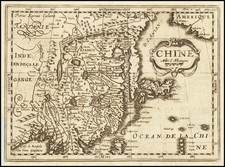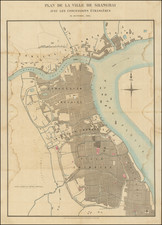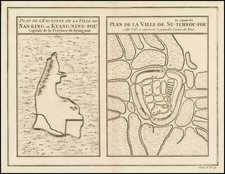Fine example of D'Anville's map of the Hubei Region.
Shows the source of the Yang-tse -Kiang River in Lake Tong-ting-Hou, along with the regional capital city of Wuhan (called Ou-Tchang-Fou) on this map.
Jean Baptiste Bourguignon d'Anville, a renowned French cartographer of the 18th century, left an indelible mark on the mapping of China, with his series of maps to illustrate du Halde's "Description geographique historique...de l'Empire de la Chine et de la Tartarie Chinoise".
This particular map showcases the Hubei Region, emphasizing the vitality of geography and topography in understanding a region. One of the highlights of this map is its illustration of the source of the Yang-tse-Kiang River in Lake Tong-ting-Hou and the pinpointing of the regional capital city of Wuhan, referred to as "Ou-Tchang-Fou" during that time.
The creation of the map was itself a product of intercultural exchange. Jesuit missionaries, who had been stationed in China since the late 16th century, played a crucial role in the exchange of knowledge between Europe and China. Their meticulous notes, observations, and records provided invaluable data for cartographers back in Europe. D'Anville's reliance on Jesuit sources demonstrates the depth of detail and accuracy these missionaries contributed to European knowledge about China. This was an era when European powers were keen on expanding their knowledge about the world, and China, with its rich history and culture, was of significant interest.
The Yang-tse-Kiang River, known today as the Yangtze River, is the longest river in Asia and holds immense significance for China, both historically and in contemporary times. By tracing its source to Lake Tong-ting-Hou, D'Anville was not merely indicating a geographical point but highlighting the river's lifeline, which played a pivotal role in trade, transport, and the cultural exchange within China. Similarly, highlighting the city of Wuhan as "Ou-Tchang-Fou" emphasizes its historical importance. Today, Wuhan stands as a major Chinese metropolis with rich history and economic significance. By the 18th century, it had already secured its place as a key regional hub.
D'Anville's map of the Hubei Region continued to be a reference point for European renderings of China's provinces for over a century.
Jean-Baptiste Bourguignon d’Anville (1697-1782) was one of the foremost French geographers of the eighteenth century. He carried out rigorous research in order to create his maps, which greatly developed the technical proficiency of mapmaking during his lifetime. His style was also simpler and less ornate than that of many of his predecessors. It was widely adopted by his contemporaries and successors.
The son of a tailor, d’Anville showed cartographic prowess from a young age; his first map, of Ancient Greece, was published when he was only fifteen years old. By twenty-two, he was appointed as one of the King’s géographes ordinaire de roi. He tutored the young Louis XV while in the service to the Crown. However, royal appointment did not pay all the bills, so d’Anville also did some work for the Portuguese Crown from 1724. For example, he helped to fill out Dom João V’s library with geographical works and made maps showing Portugal’s African colonies.
D’Anville disapproved of merely copying features from other maps, preferring instead to return to the texts upon which those maps were based to make his own depictions. This led him to embrace blank spaces for unknown areas and to reject names which were not supported by other sources. He also amassed a large personal map library and created a network of sources that included Jesuits in China and savants in Brazil. D’Anville’s historical approach to cartography resulted in magnificently detailed, yet modern and academic, maps. For example, his 1743 map of Italy improved upon all previous maps and included a memoir laying out his research and innovations. The geographer also specialized in ancient historical geography.
In 1773, d’Anville was named premier géographe de roi. In 1780, he ceded his considerable library to the Ministry of Foreign Affairs to be used for as a reference library for diplomats. D’Anville is best known for several maps, including his map of China, first published in 1735, and then included with Du Halde’s history of that country (the Hague, 1737). His map of Africa (1749) was used well into the nineteenth century.









![[Canton] Chapelle de St. Francois Xavier dans l'ile de Sancian](https://storage.googleapis.com/raremaps/img/small/82397.jpg)



![[China]. Carta della Cina e Delle Regioni Limitrofe [Map of China and Neighboring Regions]](https://storage.googleapis.com/raremaps/img/small/71547.jpg)
